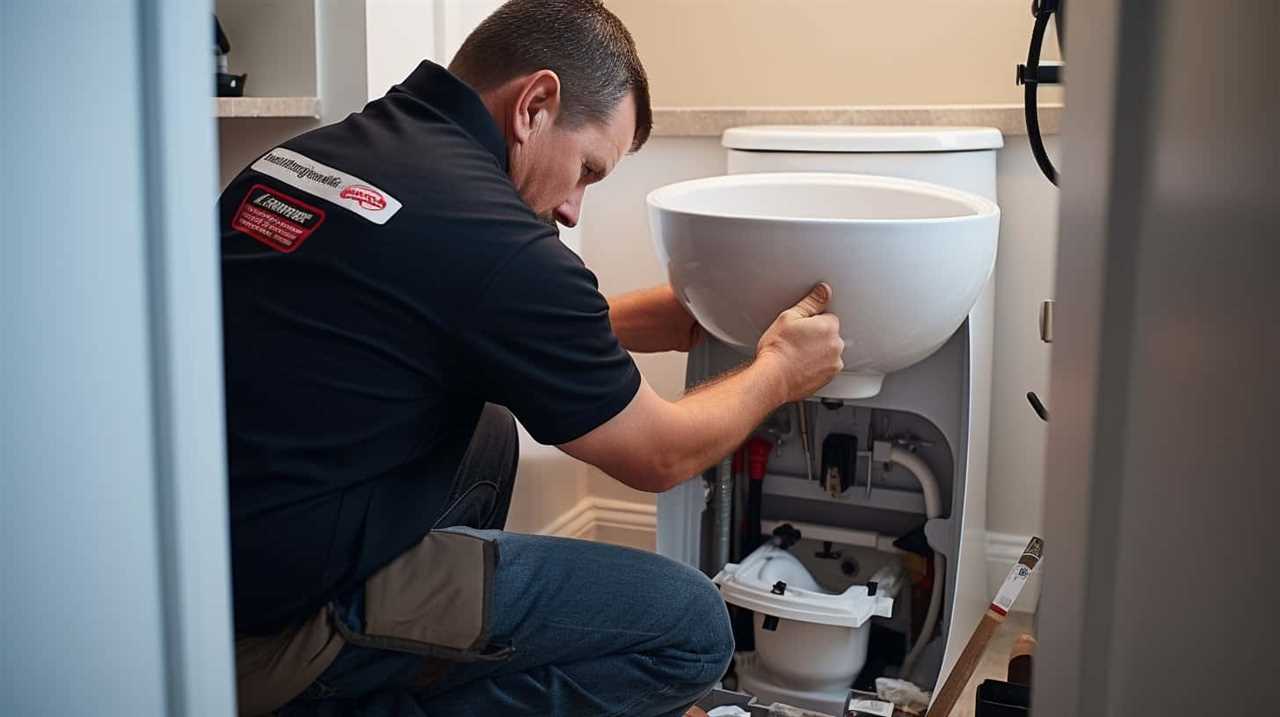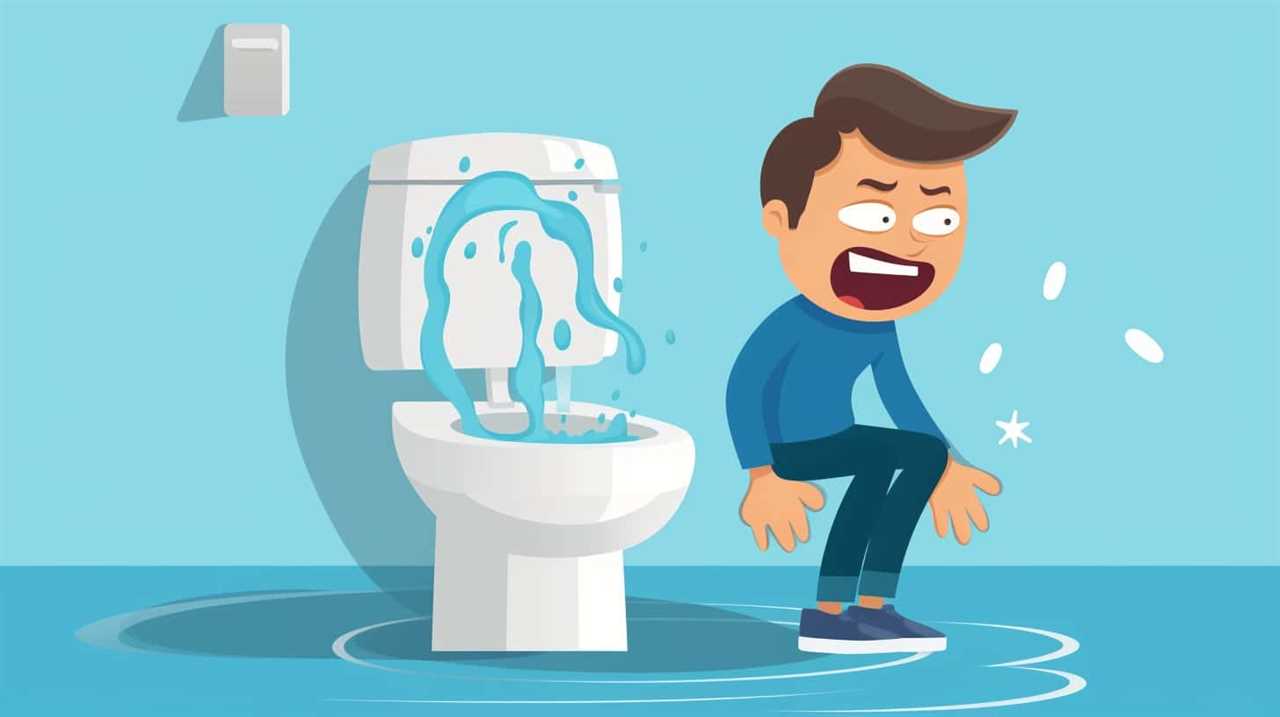Did you know that a running toilet can waste up to 200 gallons of water per day?
As someone who has dealt with this annoying problem before, I understand the frustration.
That’s why I’ve put together this step-by-step guide on how to stop your toilet from filling.
By understanding the toilet fill mechanism, identifying common causes, and adjusting the fill valve, you’ll be able to fix this issue in no time.
Plus, I’ll share some troubleshooting tips and preventive measures to ensure it doesn’t happen again.
Let’s get started!
Key Takeaways
- A running toilet can waste up to 200 gallons of water per day.
- The toilet fill mechanism consists of a fill valve connected to the water supply line and a float mechanism that controls the water level in the tank.
- Common causes of toilet overfilling include clogged drains and faulty fill valves or flappers.
- Adjusting the toilet fill valve can prevent constant running or slow filling.
Understanding the Toilet Fill Mechanism
To understand why the toilet keeps filling, you need to know how the fill mechanism works.
The toilet fill mechanism is responsible for refilling the tank after each flush. When the toilet is flushed, water rushes down the flush valve and empties the tank. The fill mechanism then kicks in to refill the tank with water.
It consists of a fill valve, which is connected to the water supply line, and a float mechanism, which controls the water level in the tank. As the tank empties, the float drops, signaling the fill valve to open and let water in. Once the tank is full, the float rises and shuts off the fill valve.
If you hear excessive toilet fill noise or notice that the toilet fill time is taking too long, it could be a sign of a faulty fill mechanism that needs to be repaired or replaced.
Identifying Common Causes of Toilet Overfilling
One common cause of a toilet overfilling is a clogged drain. When the drain is blocked, water cannot flow freely, leading to a backup in the toilet bowl. This can be caused by various factors, such as excessive toilet paper, foreign objects, or a buildup of waste materials.
To address this issue, there are potential solutions for a clogged toilet. One option is to use a plunger to create suction and dislodge the blockage. Another method is using a toilet auger, which can reach deeper into the drain to remove the obstruction. In more severe cases, professional assistance may be required.
Additionally, understanding how to fix a running toilet is crucial, as a faulty fill valve or flapper can also cause overfilling. Regular maintenance and proper usage can help prevent clogs and ensure a smoothly functioning toilet.
Step-by-Step Guide to Adjusting the Toilet Fill Valve
You can easily adjust the toilet fill valve by following these step-by-step instructions.
Proper toilet fill valve maintenance is essential to ensure the smooth operation of your toilet and prevent any potential issues. One of the signs of a faulty toilet fill valve is when your toilet constantly runs or takes longer than usual to fill up after flushing.
To adjust the fill valve, start by shutting off the water supply to the toilet.
Next, locate the fill valve, which is usually found on the left side of the toilet tank. Use a pair of pliers to turn the adjustment screw clockwise to decrease the water level or counterclockwise to increase it.
Once you’ve made the necessary adjustments, turn the water supply back on and test the toilet to ensure it fills properly.
Regular maintenance and adjustment of the toilet fill valve will help maintain the efficiency and functionality of your toilet.
Troubleshooting Tips for Persistent Toilet Filling Issues
If your toilet constantly runs or takes longer than usual to fill up after flushing, there may be a simple solution to the problem.
First, check if there is any noise coming from the toilet fill valve. A noisy fill valve could indicate a problem with the water pressure or a faulty valve. To fix this, you can try adjusting the water pressure or replacing the fill valve.
Additionally, if your toilet fill is slow, it could be due to a clogged or partially closed water supply valve. Make sure the supply valve is fully open and check for any blockages in the water line.
If the issue persists, it may be best to consult a professional plumber who can diagnose and fix the problem accurately.
Preventive Measures to Avoid Toilet Overfilling
To prevent toilet overfilling, I always make sure to regularly check the water level and ensure that the float valve is functioning properly. This is an essential part of toilet maintenance and helps in water conservation efforts.
By regularly monitoring the water level, I can detect any potential issues and take necessary steps to prevent overfilling. The float valve is responsible for controlling the water flow into the toilet tank, so it’s crucial to ensure its proper functioning. If the float valve is not working correctly, it can lead to continuous water flow and eventually result in an overfilled toilet.
Regular maintenance and checking of these components can help save water and prevent any potential toilet overfilling issues.
Conclusion
In conclusion, by following these simple steps, you can put an end to the never-ending cycle of toilet filling.
Once you understand how the toilet fill mechanism works and identify the common causes of overfilling, you can confidently adjust the fill valve to restore balance and harmony in your bathroom.
And if you encounter persistent filling issues, don’t worry! Our troubleshooting tips will help you tackle any problem head-on.
Remember, with these preventive measures, you’ll never have to witness the horror of an overflowing toilet again!










